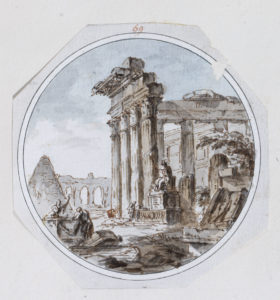
THE LETTERS
The foremost collection of 206 Adam Grand Tour letters is that belonging to the Clerk family of Penicuik, currently on long-term deposit with the National Records of Scotland at Register House, Edinburgh (class GD18). These are known from John Fleming’s study, Robert Adam and His Circle in Edinburgh and Rome (1962), published shortly after their discovery
There are two other collections of a total of 22 Adam Grand Tour letters in the care of London Metropolitan Archives (class MS CLC/B/227/MS03070) and the Royal Institute of British Architects in London (class I&C/1/1/1–3). These are mostly letters written by Robert Adam on his travels through France, Holland and Italy to the merchant bankers Innes & Clerk, the Adam family’s financial agents in London. This correspondence is particularly informative on the day-to-day aspects of money supply and sending home drawings and antiquities for clients.
Other collections. Another nine Adam Grand Tour letters are known to exist in other private and public collections in Britain, and also in America, as follows:
- Claremont College Library, California (Perkins Autograph Letter Collection): Robert Adam in Pisa to Messrs Innes & Clerk, London, 27 January 1755
- Hopetoun Papers Trust, Hopetoun House, Mid-Lothian (NRAS 888, Marquis of Linlithgow 621): Robert Adam in Rome to the 2nd Earl of Hopetoun, Hopetoun House, 3 May 1755
- Blair Adam Muniments, Fife (Acc. no. 1454/4/10/1): Robert Adam in Rome to John Adam, Edinburgh, 26 November 1756
- National Library of Scotland, Edinburgh (MS 540, no. 1606): Robert Adam in Rome to Messrs Innes & Clerk, London, 19 March 1757
- National Library of Scotland, Edinburgh (MS 23638, ff. 1–2): Robert Adam in Vicenza to Messrs Innes & Clerk, London, 12 October 1757
- Edinburgh University Library (CRC, Dc.4.41/1020): James Adam in Brussels to Alexander Carlyle, Inveresk, near Edinburgh, 21 May 1760
- National Records of Scotland, Edinburgh (GD24/1/553): James Adam in Rome to Henry Home, Lord Kames, Edinburgh, 9 May 1761
- The Archives of the Duke of Northumberland, Alnwick Castle, Northumberland (DNM G/1/2-3): ‘Extracts from James Adam’s letters at Rome [to Lord Northumberland], 1 and 14 August 1761’
*NB – if any readers are aware of any other surviving Adam correspondence of the Grand Tour period not included in the lists above, the project leaders would be very interested to hear from you. Please email us at: editors@adamgrandtour.online
APPENDICES
We also intend to include as appendices the two travel notebooks or journals written by the brothers during their Grand Tours, as well as other related material, such as later correspondence with Italian agents, which can provide valuable supplementary information and context:
- Robert Adam’s early Grand Tour notebook, 1754 (National Records of Scotland, Edinburgh, GD18/4753) – offers notes and remarks on acquaintances that he made during the early part of his Grand Tour.
- ‘Reasons and Motives for Undertaking the Voyage to Spalatro [sic.] in Dalmatia’ (National Records of Scotland, Edinburgh, GD18/4953) – Robert Adam’s own draft, unpublished introduction to his folio publication Ruins of the Palace of the Emperor Diocletian (1764) provides first-hand information about his journey there and his intentions.
- James Adam’s Italian travel journal, 1760–1 (Library of the Fine Arts, vol. II, no. 9, October 1831, pp. 165–78, 235–45) – provides a detailed account of the people that James Adam met and the places he visited during his travels through Italy with the artists Charles-Louis Clérisseau and Antonio Zucchi.
- ‘Good Antiquitys yet to be procur’d at Rome’ – a memorandum in one of James Adam’s Italian notebooks (National Records of Scotland, Edinburgh, GD18/4954) – this lists important family collections of artworks and antiquities that he thought might become available for sale.
- Five letters received by Robert & James Adam, 1764–77, from their agents and sculptors in Italy (Getty Research Institute, Los Angeles, Special Collections, 850612) – these date from after the Adams’ Grand Tour period but are rare survivals of correspondence from their representatives in Italy.
